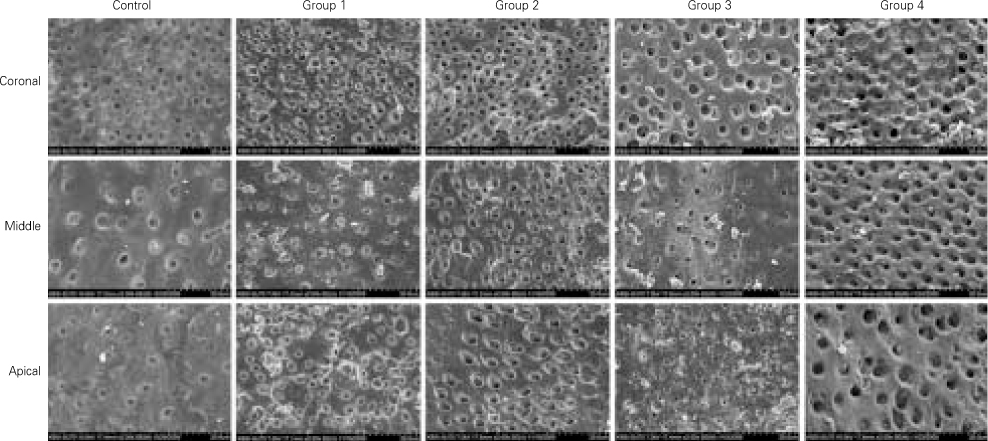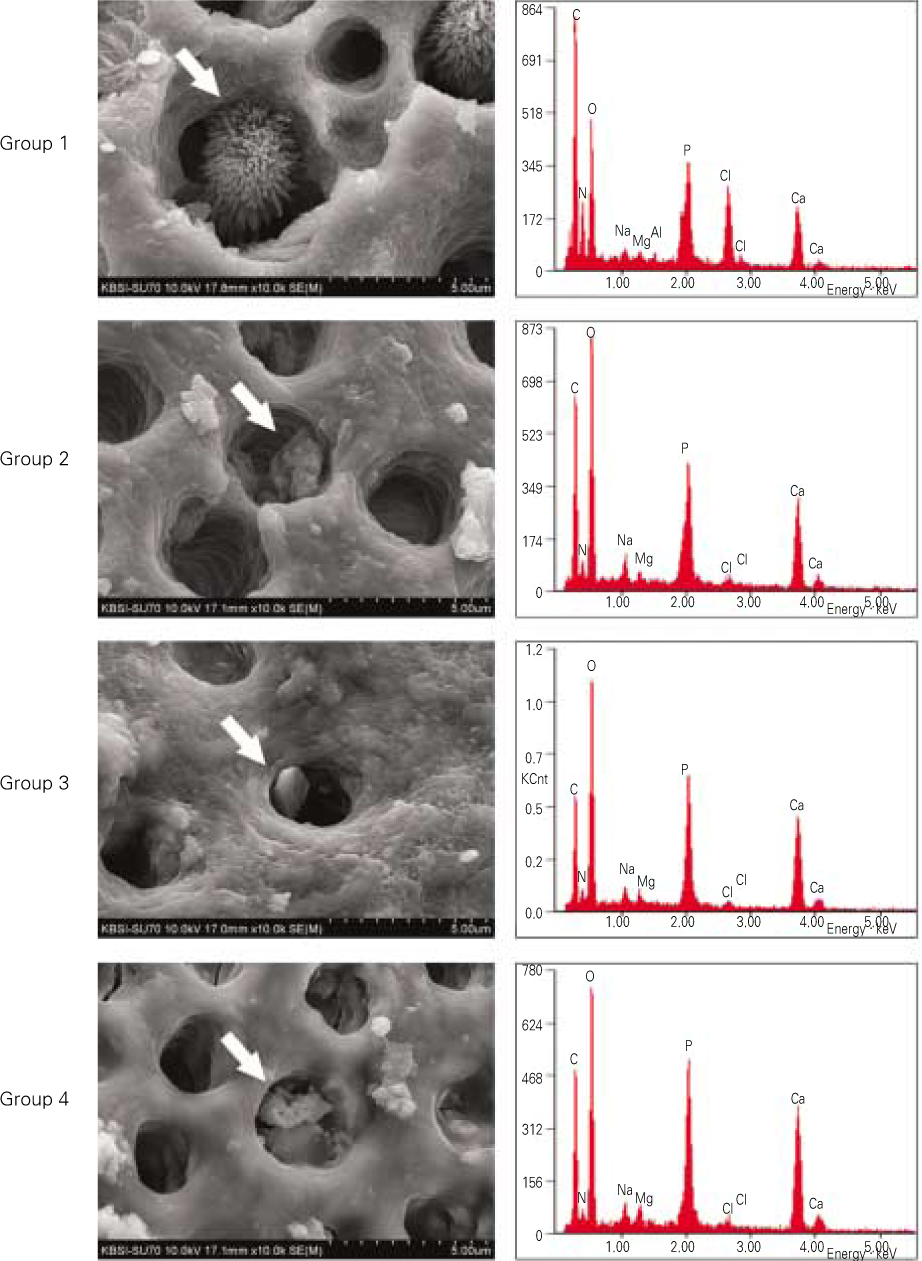Articles
- Page Path
- HOME > Restor Dent Endod > Volume 35(2); 2010 > Article
- Basic Research The comparison of different canal irrigation methods to prevent reaction precipitate between sodium hypochlorite and chlorhexidine
- Moon-Sun Choi, Se-Hee Park, Kyung-Mo Cho, Jin-Woo Kim
-
2010;35(2):-87.
DOI: https://doi.org/10.5395/JKACD.2010.35.2.080
Published online: March 31, 2010
Department of Conservative Dentistry, College of Dentistry, Gangneung-Wonju National University, Gangneung, Korea.
- Corresponding Author: Jin-Woo Kim. Department of Conservative Dentistry, College of Dentistry, Gangneung-Wonju National University, 123 Chibyon-dong, Gangneung, Gangwon-do, 210-702, Korea. Tel: 82-33-640-2470, Fax: 82-33-642-6410, mendo7@gwnu.ac.kr
• Received: February 25, 2010 • Revised: March 4, 2010 • Accepted: March 5, 2010
Copyright © 2010 Korean Academy of Conservative Dentistry
- 1,345 Views
- 5 Download
- 1 Crossref
Abstract
-
The purpose of this study was to compare the different canal irrigation methods to prevent the formation of precipitate between sodium hypochlorite (NaOCl) and chlorhexidine (CHX).Extracted 50 human single-rooted teeth were used. The root canals were instrumented using NiTi rotary file (Profile .04/#40) with 2.5% NaOCl and 17% EDTA as irrigants. Teeth were randomly divided into four experimental groups and one control group as follows; Control group: 2.5% NaOCl only, Group 1: 2.5% NaOCl + 2% CHX, Group 2: 2.5% NaOCl + paper points + 2% CHX, Group 3: 2.5% NaOCl + preparation with one large sized-file + 2% CHX, Group 4: 2.5% NaOCl +95% alcohol+ 2% CHX.The teeth were split in bucco-lingual aspect and the specimens were observed using Field Emission Scanning Electron Microscope. The percentages of remaining debris and patent dentinal tubules were determined. Statistical analysis was performed with one-way analysis of variance (ANOVA). Energy Dispersive x-ray Spectroscopy was used for analyzing the occluded materials in dentinal tubule for elementary analysis.There were no significant differences in percentage of remaining debris and patent tubules between all experimental groups at all levels (p > .05).In elementary analysis, the most occluded materials in dentinal tubule were dentin debris. NaOCl/CHX precipitate was detected in one tooth specimen of Group 1.In conclusion, there were no significant precipitate on root canal, but suspected material was detected on Group 1. The irrigation system used in this study could be prevent the precipitate formation.
- 1. Kakehashi S, Stanley HR, Fitzgerald RJ. The effects of surgical exposure of dental pulps in germ-free and conventional laboratory rats. Oral Surg Oral Med Oral Pathol. 1965;20: 340-348.PubMed
- 2. Basrani BR, Manek S, Fillery E. Using diazotization to characterize the effect of heat or sodium hypochlorite on 2.0% chlorhexidine. J Endod. 2009;35: 1296-1299.ArticlePubMed
- 3. Peters OA, Laib A, Gohring TN, Barbakow F. Changes in root canal geometry after preparation assessed by high resolution computed tomography. J Endod. 2001;27: 1-6.ArticlePubMed
- 4. Byström A, Sundqvist G. Bacteriologic evaluation of the efficacy of mechanical root canal instrumentation in endodontic therapy. Scand J Dent Res. 1981;89: 321-328.ArticlePubMed
- 5. Wu MK, van der Sluis LW, Wesselink PR. The capability of two hand instrumentation techniques to remove the inner layer of dentin in oval canals. Int Endod J. 2003;36: 218-224.PubMed
- 6. Siqueira JF, Machado AG, Silveirab RM, Lopes HP, Uzed MD. Evaluation of the effectiveness of sodium hypochlorite used with three irrigation methods in the elimination of Enterococcus faecalis from the root canal, in vitro. Int Endod J. 1997;30: 279-282.ArticlePubMed
- 7. Orstavik D, Haapasalo M. Disinfection by endodontic irrigants and dressings of experimentally infected dentinal tubules. Endod Dent Traumatol. 1990;6: 142-149.ArticlePubMed
- 8. Park JH. The effect of solvent action of sodium hypochlorite solution on pulp tissue. J Korean Acad Conserv Dent. 1982;8: 115-122.
- 9. Naenni N, Thoma K, Zehnder M. Soft tissue dissolution capacity of currently used and potential endodontic irrigants. J Endod. 2004;30: 785-787.ArticlePubMed
- 10. Siqueira JF, Batista MMD, Fraga RC, de Uzeda M. Antibacterial effects of endodontic irrigants on black-pigmented gram-negative anaerobes and facultative bacteria. J Endod. 1998;24: 414-416.ArticlePubMed
- 11. Türkün M, Cengiz T. The effects of sodium hypochlorite and calcium hydroxide on tissue dissolution and root canal cleanliness. Int Endod J. 1997;30: 335-342.ArticlePubMed
- 12. O'Hoy PYZ, Messer HH, Palamara JEA. The effect of cleaning procedures on fracture properties and corrosion of NiTi files. Int Endod J. 2003;36: 724-732.ArticlePubMedPDF
- 13. Hülsmann M, Hahn W. Complications during root canal irrigation-literature review and case reports. Int Endod J. 2000;33: 186-193.ArticlePubMed
- 14. Pashley EL, Birdsong NL, Bowman K, Pashley DH. Cytotoxic effects of NaOCl on vital tissue. J Endod. 1985;11: 525-528.ArticlePubMed
- 15. Ehrich DG, Walker WA. Sodium hypochlorite accident: inadvertent injection into the maxillary sinus. J Endod. 1993;19: 180-182.ArticlePubMed
- 16. Jenkins S, Addy M, Wade W. The mechanism of action of chlorhexidine : A study of plaque growth on enamel inserts in vivo. J Clin Periodontol. 1988;15: 415-424.PubMed
- 17. Oncag O, Hosgor M, Hilmioglu S, Zekioglu O, Eronat C, Burhanoglu D. Comparison of antibacterial and toxic effects of various root canal irrigants. Int Endod J. 2003;36: 423-432.ArticlePubMedPDF
- 18. Kim HJ, Park SH, Cho KM, Kim JW. Evaluation of time-dependent antimicrobial effect of sodium duchloroisocyanurate (NaDCC) on E. faecalis in the root canal. J Korean Acad Conserv Dent. 2007;32: 121-129.Article
- 19. Yesilsoy C, Whitaker E, Cleveland D, Phillips E, Trope M. Antimicrobial and toxic effects of established and potential root canal irrigants. J Endod. 1995;21: 513-515.ArticlePubMed
- 20. Gomes-Filho JE, Aurelio KG, Costa MMTM, Bernabe PFE. Comparison of the biocompatibility of different root canal irrigants. J Appl Oral Sci. 2008;16: 137-144.ArticlePubMedPMC
- 21. Mohammadi Z, Abbott PV. The properties and applications of chlorhexidine in endodontics. Int Endod J. 2009;42: 288-302.PubMed
- 22. Clegg MS, Britto LR. The effect of exposure to irrigant solutions on apical dentin biofilms in vitro. J Endod. 2006;32: 434-437.ArticlePubMed
- 23. Dunavant TR, Honeyman AL. Comparative evaluation of endodontic irrigants against Enterococcus faecalis biofilms. J Endod. 2006;32: 527-531.ArticlePubMed
- 24. Zehnder M. Root canal irrigants. J Endod. 2006;32: 389-398.ArticlePubMed
- 25. Kuruvilla JR, Kamath MP. Antimicrobial activity of 2.5% sodium hypochlorite and 0.2% chlorhexidine gluconate separately and combined as endodontic irrigants. J Endod. 1998;24: 472-476.ArticlePubMed
- 26. Basrani B, Manek S, Sodhi RN, Fillery E, Manzur A. Interaction between sodium hypochlorite and chlorhexidine gluconate. J Endod. 2007;33: 966-969.ArticlePubMed
- 27. Bui TB, Baumgartner JC, Mitchell JC. Evaluation of the interaction between Sodium hypochlorite and chlorhexidine gluconate and its effect on root dentin. J Endod. 2008;34: 181-185.ArticlePubMed
- 28. Vivacqua-Gomes N, Ferraz CC, Gomes BP, Zaia AA, Teixeira FB. Influence of irrigants on the coronal microleakage of laterally condensed gutta-percha root fillings. Int Endod J. 2002;35: 791-795.ArticlePubMed
- 29. Marchesan MA, Pasternak B Jr, Freitas Afonso MM, Sousa-Neto MD, Paschoalato C. Chemical analysis of the flocculate formed by the association of sodium hypochlorite and chlorhexidine. Oral Surg Oral Med Oral Pathol Oral Radiol Endod. 2007;103: e103-e105.ArticlePubMed
- 30. Shin JS, Cho YB. Removal patterns of smear layer according to application temperature and time of EDTA. J Korean Acad Conserv Dent. 2002;27: 535-542.Article
- 31. Rasimick BJ, Nekich M, Hladek MM, Musikant BL, Deutsch AS. Interaction between chlorhexidine digluconate and EDTA. J Endod. 2008;34: 1521-1523.ArticlePubMed
- 32. Zamany A, Safavi K, Spångberg LSW. The effect of chlorhexidine as an endodontic disinfectant. Oral Surg Oral Med Oral Pathol Oral Radiol Endod. 2003;96: 578-581.ArticlePubMed
- 33. Jeansonne MJ, White RR. A Comparison of 2.0% Chlorhexidine gluconate and 5.25% sodium hypochlorite as antimicrobial endodontic irrigants. J Endod. 1994;20: 276-278.PubMed
- 34. Khademi AA, Mohammadi Z, Havaee A. Evaluation of the antibacterial substantivity of several intra-canal agents. Aust Endod J. 2006;32: 112-115.ArticlePubMed
- 35. Rosenthal S, Spangberg L, Safavi KE. Chlorhexidine substantivity in root canal dentine. Oral Surg Oral Med Oral Pathol Oral Radiol Endod. 2004;98: 488-492.PubMed
- 36. Leonardo MR, Bonifácio KC. In vivo antimicrobial activity of 2% chlorhexidine used as a root canal irrigating solution. J Endod. 1999;25: 167-171.ArticlePubMed
- 37. Okazaki Y, Yamashita K, Ishii H, Sudo M, Tsuchitani M. Potential of neurotoxicity after a single oral dose of 4-Bromo-, 4-Chloro-, 4- Fluiri- or 4-Iodoaniline in Rats. J Appl Toxicol. 2003;23: 315-322.PubMed
- 38. López FU, Fachin EV, Camargo Fontanella VR, Barletta FB, Só MV, Grecca FS. Apical transportation: a comparative evaluation of three root canal instrumentation techniques with three different apical diameters. J Endod. 2008;34: 1545-1548.ArticlePubMed
- 39. Wilcox LR, Wiemann AH. Effect of a final alcohol rinse on sealer coverage of obturated root canals. J Endod. 1995;21: 256-258.ArticlePubMed
- 40. Hafner B. Energy Dispersive Spectroscopy on the SEM: A Primer. 2006;Characterization Facility, University of Minnesota; 1-26.
REFERENCES
Tables & Figures
REFERENCES
Citations
Citations to this article as recorded by 

- Analysis of para-chloroaniline after chemical interaction between alexidine and sodium hypochlorite using mass spectrometry: A preliminary study
Hyeon-Sik Kim, Seung-Hyun Han, Soram Oh, Sang-Min Lim, Yu Gu, Kee-Yeon Kum
Journal of Korean Academy of Conservative Dentistry.2010; 35(4): 295. CrossRef
The comparison of different canal irrigation methods to prevent reaction precipitate between sodium hypochlorite and chlorhexidine


Figure 1
Representative FE-SEM micrographs of root surface (2,000 ×).
Figure 2
Elementary analysis of occluded materials in dentinal tubule on FE-SEM micrograph (10,000 ×).
Figure 1
Figure 2
The comparison of different canal irrigation methods to prevent reaction precipitate between sodium hypochlorite and chlorhexidine
Mean percentage of remaining debris (Mean ± SD)
Mean percentage of patent dentinal tubules (Mean ± SD)
Table 1
Mean percentage of remaining debris (Mean ± SD)
Table 2
Mean percentage of patent dentinal tubules (Mean ± SD)

 KACD
KACD




 ePub Link
ePub Link Cite
Cite

